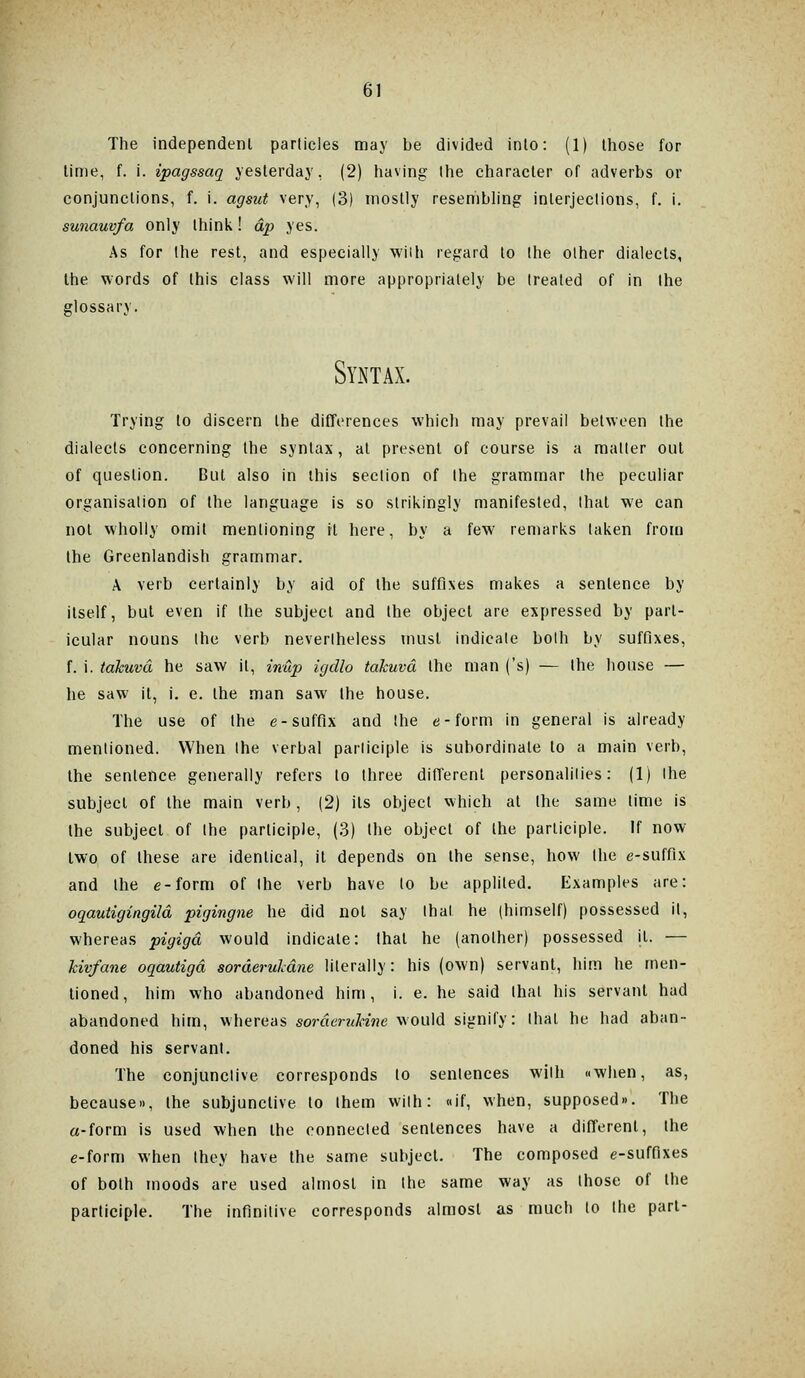
Full resolution (JPEG)
- On this page / på denna sida
- II. The Eskimo language, its admirable organisation as to the construction and flexion of words
- Particles
- Syntax

<< prev. page << föreg. sida << >> nästa sida >> next page >>
Below is the raw OCR text
from the above scanned image.
Do you see an error? Proofread the page now!
Här nedan syns maskintolkade texten från faksimilbilden ovan.
Ser du något fel? Korrekturläs sidan nu!
This page has been proofread at least once.
(diff)
(history)
Denna sida har korrekturlästs minst en gång.
(skillnad)
(historik)
The independent particles may be divided into: (1) those for
time, f. i. igpagssaq yesterday, (2) having the character of adverbs or
conjunctions, f. i. agsut very, (3) mostly resembling interjections, f. i.
sunauvfa only think! âp yes.
As for the rest, and especially with regard to the other dialects,
the words of this class will more appropriately be treated of in the
glossary.
Syntax.
Trying to discern the differences which may prevail between the
dialects concerning the syntax, at present of course is a matter out
of question. But also in this section of the grammar the peculiar
organisation of the language is so strikingly manifested, that we can
not wholly omit mentioning it here, by a few remarks taken from
the Greenlandish grammar.
A verb certainly by aid of the suffixes makes a sentence by
ilself, but even if the subject and the object are expressed by
particular nouns the verb nevertheless must indicate both by suffixes,
f. i. takuvâ he saw it, inûp igdlo takuvâ the man(’s) — the house —
he saw it, i. e. the man saw the house.
The use of the e-suffix and the e-form in general is already
mentioned. When the verbal participle is subordinate to a main verb,
the sentence generally refers to three different personalities: (1) the
subject of the main verb, (2) its object which at the same time is
the subject of the participle, (3) the object of the participle. If now
two of these are identical, it depends on the sense, how the e-suffix
and the e-form of the verb have to be applied. Examples are:
oqautigíngilâ pigingne he did not say that he (himself) possessed it,
whereas pigigâ would indicate: that he (another) possessed it. —
kivfane oqautigâ sorâerukâne literally: his (own) servant, him he
mentioned, him who abandoned him, i. e. he said that his servant had
abandoned him, whereas sorâerukine would signify: that he had
abandoned his servant.
The conjunctive corresponds to sentences with «when, as,
because», the subjunctive to them with: «if, when, supposed». The
a-form is used when the connected sentences have a different, the
e-form when they have the same subject. The composed e-suffixes
of both moods are used almost in the same way as those of the
participle. The infinitive corresponds almost as much to the
<< prev. page << föreg. sida << >> nästa sida >> next page >>
Project Runeberg, Wed Apr 17 00:06:03 2024
(aronsson)
(diff)
(history)
(download)
<< Previous
Next >>
https://runeberg.org/eskimotrib/0081.html



